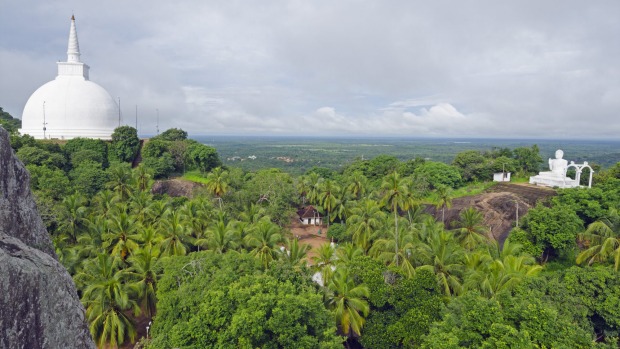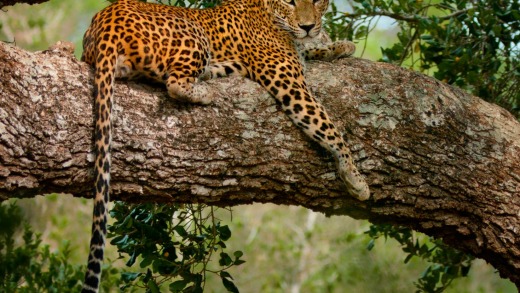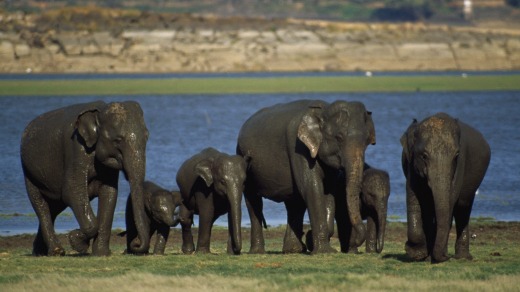
It has been five years since Sri Lanka's guerilla group, the Tamil Tigers, were defeated by the Sri Lankan military. These days, the tear drop-shaped island nation is attracting the world's attention for the wildlife that roam its national parks.
There are many reasons why nature enthusiasts should visit Sri Lanka. The island, which is about the size of Tasmania and has similar latitude to southern Thailand, has 24 wildlife reserves home to 92 mammal species, hundreds of different kinds of butterflies, birds, fish species and 98 types of snakes, including the king cobra.
The island is one of 25 biodiversity hotspots in the world and was home to the world's first wildlife sanctuary, Mihintale (declared a wildlife sanctuary in 247BC by King Devanampiya Tissa), 13 kilometres east of the ruins of Anuradhapura.
Although Sri Lanka is separated from India by a strip of water, the Gulf of Mannar, unlike India it has no tigers. But it does have golden jackals, shaggy sloths, civets, armour-plated Indian pangolins, Asian elephants, leopards, sloth bears, five-striped palm squirrels, purple-faced langurs and wild boars which roam its forests. And there's a good chance of spotting leopards in several national parks.

Here are some top places to spot wildlife.
Here you will find leopards, elephants, sloth bears, wild boars, antelopes, crocodiles and hornbills.
The park has a diverse topography that ranges from open parkland to dense jungle. It also has plenty of waterholes, streams, lakes and lagoons that wildlife are drawn to.

The wildlife rollcall includes sambar and spotted deer, buffaloes, wild pigs, stripe-necked and ruddy mongoose, langur and toque monkeys, golden jackals and Indian palm civets.
Freshwater, scrub and woodland areas attract more than 200 species of birds and it's possible to tick off 100 different species in a day.
The park is best known as the place to spot leopards. In some areas of the park, there's a density of one leopard to each square kilometre. The downside is it can get hectic and a leopard sighting can quickly turn an area into a parking lot of vehicles.
Best for Leopards
Where 300 kilometres south-east (about a six-hour drive) of Colombo. Stay at Priyankara Hotel, Kataragama Road, Tissamaharama, see priyankarahotel.com/
During the dry season (between June and September) the world's largest gathering of Asian elephants congregate in this park. Elephants migrate from surrounding forests to seek out the lush grass fields on the banks of the Minneriya reservoir.
Although elephants are a huge drawcard, there are hundreds of other animals, including endemic monkeys, such as the toque monkey, and endemic reptiles, such as the painted-lip lizard.
Other species to tick off the list are saltwater crocodiles, Indian pythons, water monitors, hanuman langurs, jackals, barking and spotted deer and leopards.
The scrubby areas around the Minneriya reservoir are a haven for local birds, such as the Ceylon junglefowl, brown-capped babbler, Ceylon grey hornbill and black-capped bulbul.
Best for Elephants
Where Central northern Sri Lanka, between Habarana and Polonnaruwa. Stay at Sigiriya Village, Sigiriya, Sri Lanka, see sigiriyavillage.com/
Turtles in Sri Lanka are threatened by ocean pollution and through becoming entangled in fishing nets. For centuries, turtles have also been hunted by locals who use their shells to make ornaments and consume their eggs and turtle meat.
There are five varieties of turtles in Sri Lanka: the olive ridley, loggerhead, green, hawksbill and leatherhead.
Near the historic city of Galle, the Habaraduwa Turtle Hatchery is re-educating locals and saving turtles through a program of incubating, hatching and releasing them into the ocean.
The hatchery has been operating since 1986. It buys turtle eggs from fishermen and local people. About 4000 eggs are kept in incubators each month, of which around 3200 are hatched. The hatchery also cares for sick and injured turtles.
At the hatchery, a few varieties of turtles are displayed in tanks.
Best for All kinds of sea turtles.
Where Habaraduwa is located in the outskirts of Galle. The hatchery is open from 8am to 6.30pm every day, see seaturtlefarm.org/. Stay at Galle Fort Hotel, Galle. See galleforthotel.com/
Established in 1954, the unique feature about Gal Oya National Park is it offers both boat and jeep safaris.
There are three mountains (the highest peak is 900 metres) and the main catchment area of Sri Lanka's largest reservoir, the vast Senanayake Samudra, is located within the park.
On land, there are 32 species of mammals, including Asian elephants, leopards, water buffaloes, sambar deer, toque monkeys, wild boards and sloth bears.
Boat safaris lure bird lovers who flock to Bird Island for nesting birds and roam the park in search of species like rare lesser adjutants, white-bellied eagles and grey-headed eagles.
Best for Elephants and birds. The best time to visit is between March and July to see herds of elephants swimming from island to island.
Where South-east Sri Lanka. The park entrance is 20 kilometres west from Ampara at Inginiyagala. Guest houses are available at Inginiyagala or Arugam Bay (about 80 kilometres away).
A patchwork of emerald undergrowth and lakes, Wilpattu National Park is Sri Lanka's largest and oldest national park. Terrorist activity in the park has kept it closed for the larger part of 30 years.
The unique feature of this park is its willus, or natural lakes, sand-rimmed water basins filled with rainwater.
Located in the north-west coast lowland dry zone of Sri Lanka, there are spotted deer, serpent eagles, crocodiles and peacocks. And around 120 leopards roam the park.
Best for Spotting leopards without the crowds.
Where 30 kilometres west of Anuradhapura and 26 kilometres north of Puttalam. Both cities have local hotels and guest houses.
The writer was a guest of Bunnik Tours.
srilanka.travel
smartraveller.gov.au/zw-cgi/view/Advice/Sri_Lanka
A Taste of Sri Lanka includes safaris in Minneriya National Park and Yala National Park, a bird-spotting boat trip on Ging Oya River and a visit to the Habaraduwa Turtle Hatchery. The 17-day trip costs from A$4376. The price includes airfares from Melbourne or Sydney, accommodation, some meals, airport transfers and tips. See bunniktours.com.au
Tip: Buy a mobile phone and local SIM card for 3500LKR ($28) at the airport.
1 A boat ride on the Gin Oya River in Negombo is a relaxing experience and the opportunity to spot birds and water monitors.
2 The Pinnawala Elephant Orphanage is a scenic place to stop for lunch while on a road trip around Sri Lanka. The orphanage cares for orphaned and injured elephants.
3 Sinharaja Rainforest Reserve is a World Heritage area with tall trees (some are 50m high) and is an ecosystem for rare species of endemic birds, such as the red-faced malkoha, the Sri Lankan blue magpie, the ashy–headed babbler, the white-headed starling and the rare green-billed coucal.
4 A whale and dolphin-spotting cruise at Dondra Point in southern Sri Lanka is best between December and April, when there's a good chance of spotting sperm whales, blue whales and spinner dolphins.
5 Udawalawe National Park has around 600 elephants, so there's a high chance of close encounters while on a game drive.